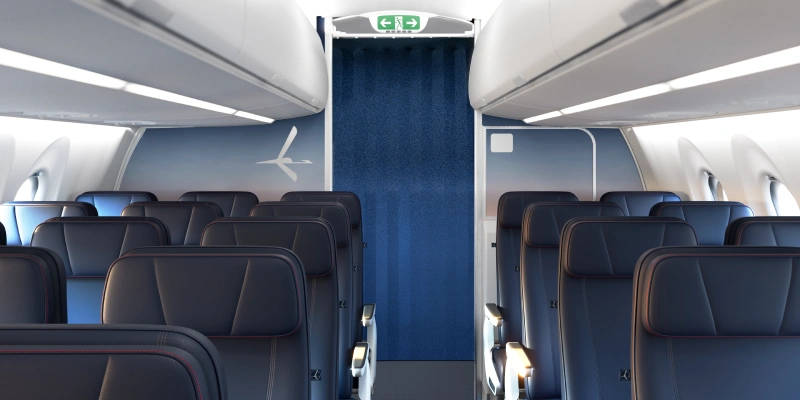The new Departures Terminal at Ezeiza International Airport in Buenos Aires was inaugurated this Friday and will start operations on Monday, April 17, which represents a milestone in the year that marks the 25th anniversary of Aeropuertos Argentina 2000’s concession. The new 50,000 m2 complex required an investment of US$230 million and more than 2,500 people worked on its construction.
The project is one of the most important in the history of Argentine infrastructure. The terminal will improve the passenger experience by making it safer, more agile and comfortable, with faster and more efficient boarding processes.
The terminal was inaugurated by the President of the Nation, Alberto Fernández, together with the Minister of Transportation of the Nation, Diego Giuliano; the President of the Regulatory Body of the National Airport System (ORSNA), Carlos Lugones Aignasse and the President of Aeropuertos Argentina 2000, Martín Eurnekian. The ceremony, held on the second floor of the building, was attended by the president of Corporación América, Eduardo Eurnekian, the CEO of Aeropuertos Argentina 2000, Daniel Ketchibachian, representatives of the airport industry, businessmen, governors, national legislators, ambassadors and municipal mayors.
“This work is a symbol of our strong commitment to the country and to the modernization of the 35 airports we operate in Argentina, a beacon that has been guiding us since we took over the concession exactly 25 years ago,” said Martín Eurnekian, president of Aeropuertos Argentina 2000. And he highlighted: “In these 25 years we have invested more than 2.5 billion dollars in more than 300 works in 21 provinces, the city of Buenos Aires and 35 airports”.
The new Departures Terminal
The terminal stands out with its 230 meters long and 45 meters high. It has the capacity to process 30 million passengers per year, since boarding processes are carried out in less time, improving them substantially. In 2022, the total traffic at Ezeiza airport was 7,459,288 passengers, between international and domestic.
→ London City Airport scraps 100ml liquid rule
The new building is 50,000 m2 -more than ten soccer fields- and has a check-in area organized in 5 independent islands with 150 counters, 72 self check-in stations, 24 automatic baggage dispatch stations, commercial premises and great gastronomic options recognized by users.
The Departures Terminal includes accessibility concepts, furniture adapted for people with reduced mobility (check-in area) and the Accessible Information Center with touch perception (haptic plane). This provides functionality and a smooth and accessible experience for all passengers.
It is 100% powered by renewable energies, uses LED lighting technology and state-of-the-art liquid cooling units (chillers) for air conditioning, which produce savings of up to 60% in energy consumption. In addition, the efficiency in waste separation and presence detectors optimize water and electricity consumption. These actions are part of the company’s sustainability policy aimed at reducing carbon emissions.
Its architectural design includes a building structure inside another one in the shape of a giant Zeppelin at the height of the second floor, through which passengers will access the security and immigration control area, the commercial area and the pre-boarding sectors.
The Zeppelin is a 190-meter long building inside the terminal, contained by a 950-ton metal structure in the shape of a net, covered by more than 2,100 laminated tempered glass panes, which allow contact with the exterior and the entry of natural light.
By accessing this sector, passengers will go through immigration procedures much faster, as it is designed so that this process takes place in a natural way, without congestion and with much shorter and more agile procedures. The equipment for the check-in and boarding process is prepared for the future implementation of biometric controls, which will speed up the process even more.
The four scanning system equipment (scanjet) that allows for an agile inspection of carry-on baggage, since it separates those items that need to be inspected by PSA personnel and has continuous tray replenishment.
As part of the digital experience, a concept proposed by the new departures terminal, there is also a Baggage Handling System (BHS), unique in the region, which includes 20 Self Baggage Drop-off stations where passengers print their own label and automatically check their baggage through state-of-the-art equipment that directs it to any point on the platform, in much less time and in a secure manner. In this way, and together with Self Check-in, waiting times are reduced and boarding processes are streamlined.
Related Topics
Delta Strengthens Its Presence in Boston with New Nonstop Routes to Madrid and Nice
LOT Polish Airlines Reveals Cabins of Its New Airbus A220
Finnair to Fly to Florence, Catania, Valencia, and Kos in Summer 2026
Boeing Moves Up Deliveries: Ryanair to Receive 25 New 737 MAX Jets Earlier Than Planned

Plataforma Informativa de Aviación Comercial con 13 años de trayectoria.




